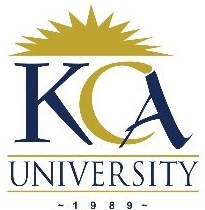 UNIVERSITY EXAMINATIONS: 2017/2018
UNIVERSITY EXAMINATIONS: 2017/2018
EXAMINATION FOR THE DEGREE OF BACHELOR OF SCIENCE IN
INFORMATION TECHNOLOGY /BACHELOR OF BUSINESS IN
INFORMATION TECHNOLOGY
BIT 2103/BBIT 200: PRINCIPLES OF ARTIFICIAL INTELLIGENCE
FULL TIME/PART TIME/DISTANCE LEARNING
DATE: AUGUST, 2018 TIME: 2 HOURS
INSTRUCTIONS: Answer Question One & ANY OTHER TWO questions.
QUESTION ONE
a) . Define the term “Artificial Intelligence” [2 Marks]
(b) Describe any three artificial intelligence applications [3 Marks]
(c) Briefly explain the meaning of the following artificial intelligence terms and give one example for
each case
(i) Atomic sentence [2 Marks]
(ii) Proposition [2 Marks]
(iii) Predicate [2 Marks]
(iv) Logical connective [2 Marks]
b) . Answer the following questions by indicating whether the statements are True (T) or False (F).
[5 Marks]
(i) Un informed searching algorithms are efficient
(ii) Depth-first search is an example of un informed searching method.
(iii)Breadth first algorithm is optimal.
(iv)Greedy search algorithm is complete
(v) Intelligent agents are rational
(c) Translate the following statements into predicate logic [4 Marks]
i. All men are mortal
ii. All KCAU students are good
d) . A search tree is shown below where each circle represents a node corresponding to a state in the
search space. The estimated cost (i.e. h function) for finding a solution from a node is shown in its circle.
The two nodes with h = 0 are goal states and the other terminal nodes are dead-ends. (i.e. states that can
never reach a goal). Actual link costs are marked on the links between the nodes. Thus the path cost (i.e.
g function) of a node is equal to the sum of the link costs from the root to that node.
i).Using the depth-first search algorithm, give the sequence of nodes expanded before a goal state is
reached. What is the path cost? [3 Marks]
ii).Using the breadth first search algorithm, give the sequence of nodes expanded before a goal state is
reached. What is the solution path and what is its path cost? [3 Marks]

(e) Give that P is false, Q is true and R false, use truth table to determine the truth value of the following
Expression [2 Marks]
![]()
QUESTION TWO
a) Describe the meaning of the term “knowledge base” [2 Marks]
b) Discuss five elements of a search problem in artificial intelligence. [5 Marks]
c) State and explain any two informed searching techniques. Use an example to illustrate how each
technique can be implemented [4 Marks]
(d) Define the term “inference” [1 Mark]
(e) Describe the difference between the following inferencing techniques. Use an example to illustrate
each method
i) Inductive and deductive Inference [4 Marks].
ii) Backward chaining and Forward chaining inference [4 Marks].
QUESTION THREE
(a) Explain the meaning of the term “knowledge representation”. [2 Marks]
(b)Describe any three techniques of representing knowledge. [6 Marks]
(c). Describe five characteristics of a good knowledge representation technique. [5 Marks]
(d).Briefly explain two assumptions of knowledge representation. Give one example for each assumption
[4 Marks]
e). Briefly explain any three reasons why it is a difficult step in knowledge engineering. [3 Marks]
QUESTION FOUR
(a)Outline four characteristics of an expert system [4 Marks]
(b) State and explain five participants of developing expert systems [5 Marks]
(c) Describe seven components of an expert system. [7 Marks]
(d) Different between the following types of agent’s environments [4 Marks]
i) Accessible v in accessible
ii) Episodic vs. non-episodic
QUESTION FIVE
(a) Briefly explain the following artificial intelligence terms:
(i) Intelligent agent [2 Marks]
(ii) Percepts [2 Marks]
(iii) Actuators [2 Marks]
(b) State and explain any four types of intelligent agents [4 Marks]
(c) Describe any four properties of an intelligent agent [4 Marks]
(d). you are given an expert system with several rules pertaining to the interpersonal skills of a job
applicant
R1: if the applicant answers questions in straight forward manner then she is easy to converse with
R2: If the applicant seems honest then she answers in straight forward manner.
R3: If the applicant has item on her resume that are found to be untrue then she does not have honest.
R4: If the applicant is able to arrange an appointment with the executive assistant then she is able to strike
up a conversation with the executive assistant.
R5: IF the applicant strikes up a conversation with the executive assistant and the applicant is easy to
converse with then she is amiable.
R6: If the applicant has adequate interpersonal skills. Then we will offer her the job.
Solve the following problems:
i) Assume that the applicant does not have any items or her resume that are found to be untrue and that
she is able to arrange an appointment with the executive assistant. Run a forward chain analysis to find
out whether we will offer her a job. [2 Marks]
ii) It is known that the applicant answers questions in straight forward manner. Run backward chain
analysis to find out whether we will offer a job to the applicant. [2 Marks]
iii) We have just discovered that the applicant was able to arrange an appointment with the executive
assistant. It is also known that she is honest. Doest she have interpersonal skills? [2 Marks]